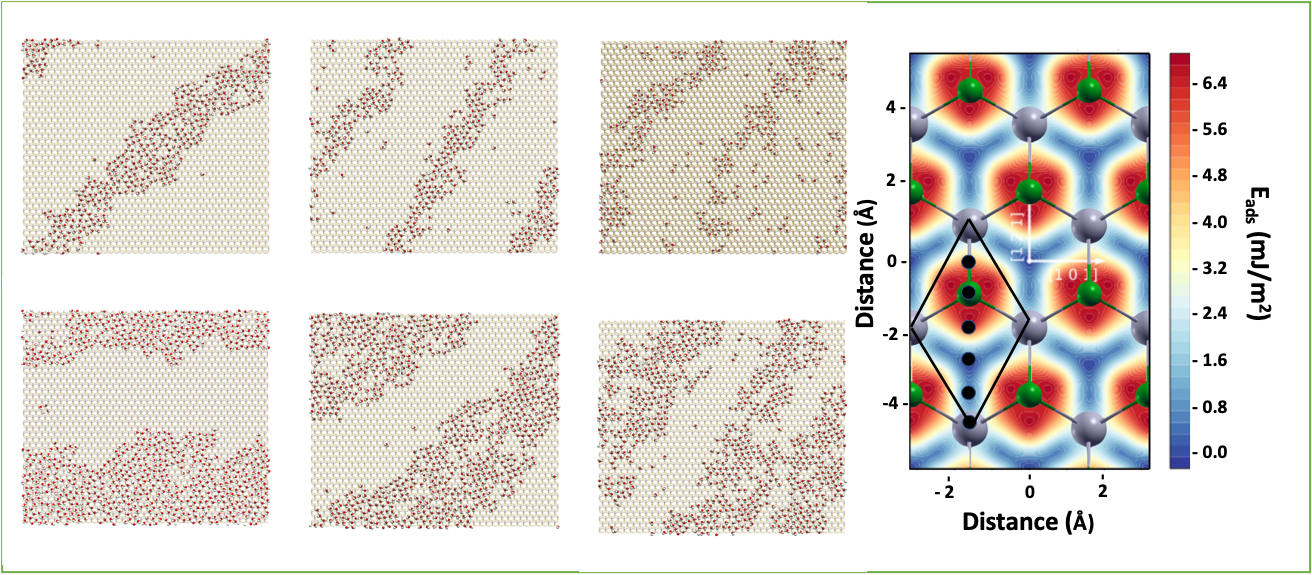In our recent manuscript entitled “Effects of intercalated water on the lubricity of sliding layers under load:a theoretical investigation of MoS2” presents an original theoretical approach combining findings from ab-initio calculations (DFT) and classical molecular dynamics to provide an atomistic insight on the role of intercalated water in modifying frictional mechanisms of solid lubricants, taking MoS2 as our case study.
Currently, there is significant interest in employing 2D-materials, e.g. graphene and MoS2, as lubricants as they display low shear strength. However, several experimental groups have observed a strong sensitivity of the tribology of these materials to humid environments. For example, graphite is a very poor lubricant in vacuum and humidity reduces the friction that results from the sliding motion of graphene sheets. In contrast to this, MoS2, despite having a similar layered structure, consistently exhibits an increase in interfacial friction when exposed to high humidity conditions, while observing low friction in vacuum environments.Theoretical modelling can play a fundamental role in explaining these observations. In particular, we take the findings from recent ab-initio studies of MoS2 as our starting point to carry out a classical molecular dynamics investigation. Classical molecular dynamics simulations enable us to explore various severe external conditions and model much larger systems than the ones investigated with DFT giving us access to the emergence of possible macroscopic behaviours. We investigated the behaviour of water molecules confined between two slabs of MoS2 under shear in the x-direction and external normal load. We looked at two different water coverages between the slabs (25%and 50%, where a full layer coverage is defined as one water molecule per MoS2 unit) and multiple external loads ranging from 0.2 to 11 Giga-Pascal (GPa). These are our key findings:
- We identify two distinct friction regimes. In the low normal load regime (0.2-3 GPa), we see higher friction for the lower water coverage. At around 5 GPa there is a crossing point and the higher coverage system shows a higher friction coefficient (5-11 GPa).
- In the low pressure regime (0.2-1 GPa) the water-water interactions prevail over the water-slab interactions.We observe the formation of large and ordered stripes as water will more easily diffuse on the PES and occupy positions that optimise the inter-molecular interactions rather than those that optimise the molecule-substrate interaction. This can be directly related to the fact that surface corrugation increases with the external load.
- At high pressure, because of the higher load, the water-slab interactions start to compete with the water-water interactions. We see that at higher pressures the corrugation of the surface also becomes higher; water remains trapped in the minima of the PES for longer time forming less ordered stripes and smaller clusters.
- The external load prevents water molecules from forming large and ordered structures between slabs. The emergence of small islands at higher external loads causes water to become commensurate with the surfaces and ultimately causing the friction coefficients to increase.
- Our approach and observations, combining the analysis of the effects of the load-dependent PES corrugation(obtained with DFT) on the water structures and diffusion properties (observed with classical MD simulations),have the potential to be generalised to all solid lubricants to elucidate the correlation between microscopic and macroscopic friction properties.

Full references: Effects of intercalated water on the lubricity of sliding layers under load: a theoretical investigation on MoS2. Martina Stella, Christian D. Lorenz & Maria Clelia Righi, 2D Materials (2021) doi: 10.1088/2053-1583/ac07ed.
